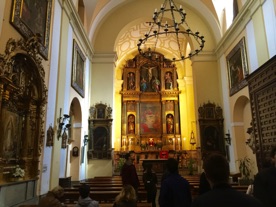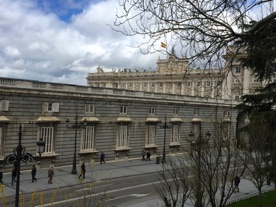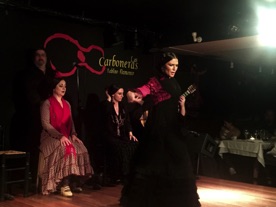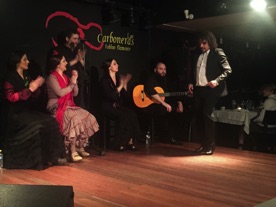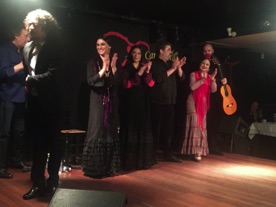Madrid 4 11 16
Click on photo to begin slide show. Slides advance every five seconds. Use manual controls to pause, speed up or slow down.
On our first full day in Madrid, we linked up with a tour company called Sandeman's for a free, walking tour of the city. Their guides depend entirely on tips and, consequently, they are quite good. They operate in several European cities.

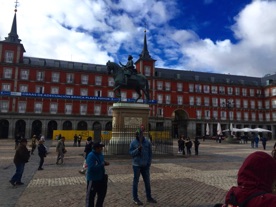
The tour started in the Plaza Mayor, a huge square surrounded by three-story apartment buildings, most with balconies. Dating from the 16th century, the Plaza has had many names over the years; its current name dates from the Spanish Civil War.
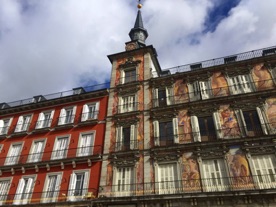
The Plaza has been the scene of many events including markets, bullfights, football games and executions, some from the Spanish Inquisition. It measures 423 by 308 feet.
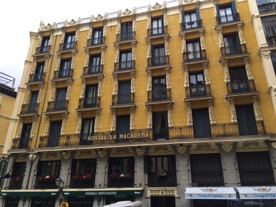
There have been a number of fires in the buildings but today the Plaza looks very well maintained and attractive.
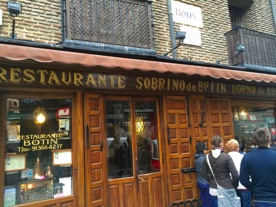
Our second stop was the Sobrino de Botín, billed as the oldest continually operating restaurant in the world dating from 1725. The artist, Goya, once worked here as a waiter. It is mentioned in Hemingway's "The Sun Also Rises."
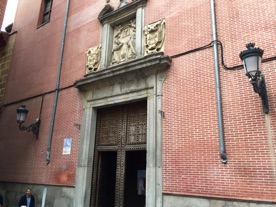
Nearby, we saw the Convento de las Carboneras del Corpus Christi. A picture of the Virgin Mary was found in a coal bunker and donated to the convent (hence the name).
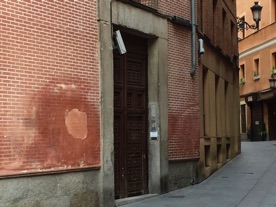
Today, the nuns here make very good pastries that are available only during certain hours of the day and via a relatively hidden window.
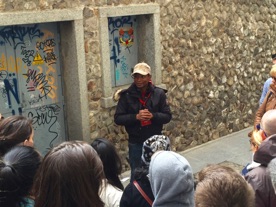
Our guide for the tour. He was American, quite a character and very entertaining. He has lived in several cities around the world.
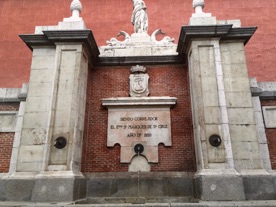
The fountain in the Plaza de la Cruz Verde. The statue is of the Goddess Diana. Many Spanish Inquisition executions were carried out near this site.
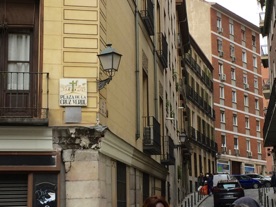
Terrorism violence by the Basque ETA group took place in Plaza de la Cruz Verde in 1992 before the Barcelona Olympics. Several persons were killed by a car bomb and many buildings were damaged.
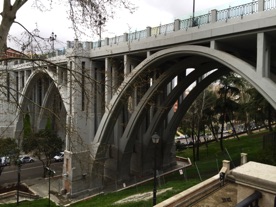
The Viaducto de Segovia. Although hard to see from the photo, there is a plexiglass fence along the top of the original fence next to the pedestrian walkways. Until the extra fencing was installed, this was a prime suicide site in Madrid. In the 1990s. an average of four persons per month jumped the 80 feet from the top of the bridge.
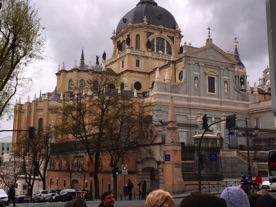
Spain's capital was transferred from Toledo to Madrid in 1561 but the center of Catholicism remained in Toledo. For some time, Madrid had no cathedral. In 1879, construction of this cathedral, Santa María la Real de La Almudena, began.
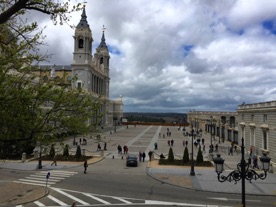
The Cathedral on the left faces the Royal Palace on the right. The Palace is officially the residence of the royal family but is now used only for ceremonial occasions. The royal family lives on the outskirts of Madrid.
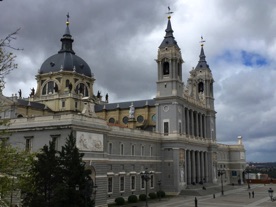
The Cathedral is built on the site of a former mosque destroyed in 1083. The Cathedral was consecrated by Saint John Paul II in 1993.
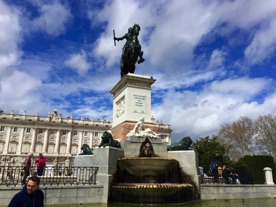
The beautiful Plaza de Oriente is next to the Royal Palace. It dates from 1844. The statue is Philip IV, king of both Spain and Portugal. He died in 1665 and was a noted patron of the arts.
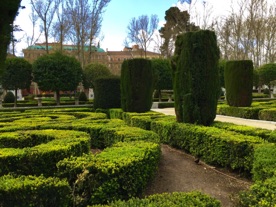
The Plaza is built on the site of the former Habsburg Palace that was demolished in 1997 for a parking garage now below the park.
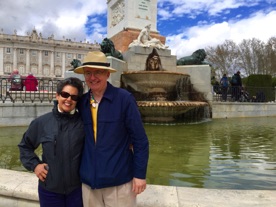
Almost everyone in the group had their photo taken by our tour guide in front of the fountain topped by the Philip IV statue.
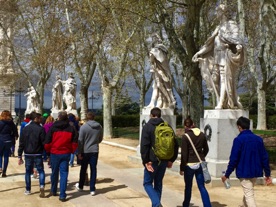
There are numerous statues of monarchs in the Plaza. They were supposed to have been installed on top of the Royal Palace but architects decided they were too heavy and , thus, they ended up at ground level.
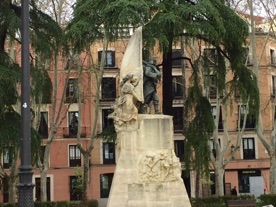
Monument to Luis Noval Ferrao, a Spanish soldier killed heroically in 1909 as he warned Spanish forces about the approaching Moor troops in Morocco.
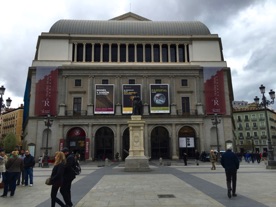
The Teatro Real de Madrid, the Madrid Opera house. It opened in 1850 and closed in 1925 not to reopen until 1997. It seats 1,746 and is considered one of the great theaters of Europe.
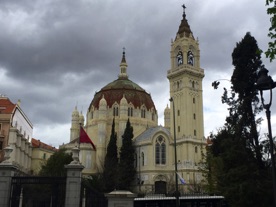
Church of San Manuel y San Benito, located across from Retiro Park and very close to our hotel. The church dates from the beginning of the 20th century.
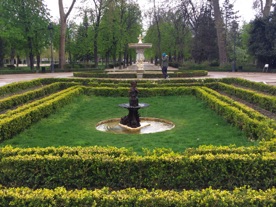
Retiro Park, one of Madrid's largest parks. It was owned by the monarchy until the late 19th century when it became a public park.
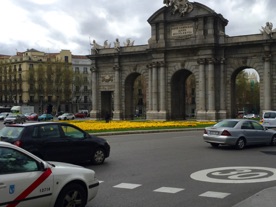
Puerta de Alcalá, Independence Plaza, next to Retiro Park. A number of events have taken place at the monument including the 1921 assassination of the Spanish Prime Minister, Eduardo Dato.
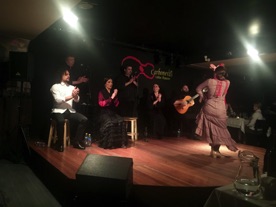
After lunch and a rest back at the hotel, we embarked on an evening of flamenco. However, the rain had started again and we got stuck in a massive Madrid traffic jam on the way to the restaurant. The restaurant was Tablao Las Carboneras, very close to the location we visited in the morning where the nuns sell their pastries.
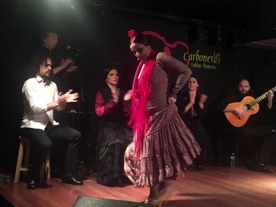
Flamenco dancing is a Spanish art form that originated in the 18th century with strong influence of Andalusia, Spain's southernmost region.
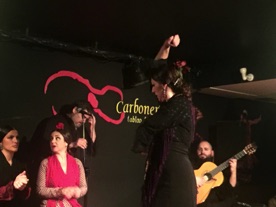
Flamenco has become popular throughout the world, particularly in the U.S. and Japan. Japan has more flamenco dance academies than Spain.
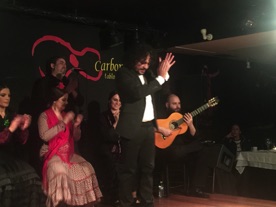
José Greco was one of the most famous flamenco dancers performing worldwide in the 1950s and on the Ed Sullivan Show.
NOTE: The browser back button will usually take you to same spot on the Itinerary Page; if not, click the link above to take you to the top of the Itinerary Page.
